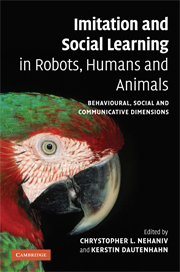 Imitation and Social Learning in Robots, Humans and Animals
Imitation and Social Learning in Robots, Humans and Animals Book contents
- Frontmatter
- Contents
- List of plates
- List of figures
- List of tables
- List of contributors
- Introduction: the constructive interdisciplinary viewpoint for understanding mechanisms and models of imitation and social learning
- Part I Correspondence problems and mechanisms
- Part II Mirroring and ‘mind-reading’
- Part III What to imitate?
- Part IV Development and embodiment
- Part V Synchrony and turn-taking as communicative mechanisms
- Part VI Why imitate? – Motivations
- 16 Multiple motivations for imitation in infancy
- 17 The progress drive hypothesis: an interpretation of early imitation
- Part VII Social feedback
- Part VIII The ecological context
- Index
- Plate section
- References
17 - The progress drive hypothesis: an interpretation of early imitation
Published online by Cambridge University Press: 10 December 2009
- Frontmatter
- Contents
- List of plates
- List of figures
- List of tables
- List of contributors
- Introduction: the constructive interdisciplinary viewpoint for understanding mechanisms and models of imitation and social learning
- Part I Correspondence problems and mechanisms
- Part II Mirroring and ‘mind-reading’
- Part III What to imitate?
- Part IV Development and embodiment
- Part V Synchrony and turn-taking as communicative mechanisms
- Part VI Why imitate? – Motivations
- 16 Multiple motivations for imitation in infancy
- 17 The progress drive hypothesis: an interpretation of early imitation
- Part VII Social feedback
- Part VIII The ecological context
- Index
- Plate section
- References
Summary
Introduction
The functional role of early imitation has been discussed in a variety of contexts. Its role for the cognitive development of the child has been regularly emphasized since Piaget (1962). Its communicative function and its role for the development of social coordination know-how have also been put forward (Nadel, 2002). Early imitative capabilities could also be important in the process of identification with others helping the very young infant to take a ‘like-me stance’ (Meltzoff and Gopnick, 1993). Eventually, it has been argued that infants also engage in ‘self-imitation’ and that this process is crucial for the objectivation of themselves as distinct entities (Rochat, 2002). This multiplicity of approaches points to a consensus that early imitation is a crucial basic mechanism for the development of cognitive, social and communicative aspects of children's behaviour and even more generally for the construction of their awareness about themselves, others and the external environment. Despite its importance, a question regarding early imitation remains only partially answered: what pushes animals and infants to engage in imitative behaviour?
Early imitation seems to appear at an age when children do not discriminate clearly between themselves and others. It is argued that early imitation actually plays a role for identification with and discrimination from others. As a consequence, potential mechanisms for early imitation should not rely on the notions of self and others.
- Type
- Chapter
- Information
- Imitation and Social Learning in Robots, Humans and AnimalsBehavioural, Social and Communicative Dimensions, pp. 361 - 378Publisher: Cambridge University PressPrint publication year: 2007
References
- 10
- Cited by
